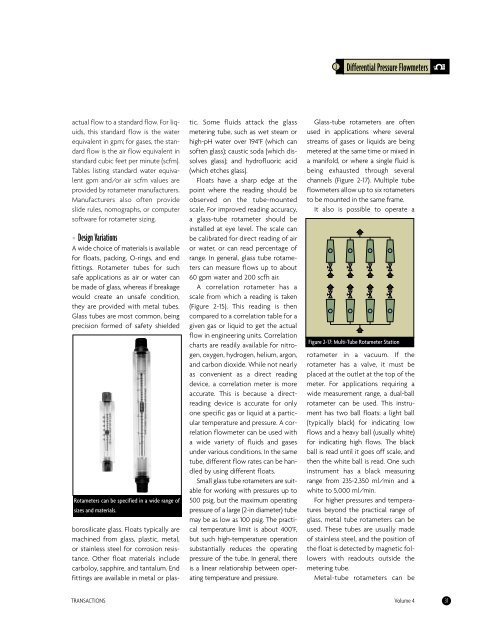flow and level measurement - Omega Engineering
flow and level measurement - Omega Engineering
flow and level measurement - Omega Engineering
Create successful ePaper yourself
Turn your PDF publications into a flip-book with our unique Google optimized e-Paper software.
actual <strong>flow</strong> to a st<strong>and</strong>ard <strong>flow</strong>. For liquids,<br />
this st<strong>and</strong>ard <strong>flow</strong> is the water<br />
equivalent in gpm; for gases, the st<strong>and</strong>ard<br />
<strong>flow</strong> is the air <strong>flow</strong> equivalent in<br />
st<strong>and</strong>ard cubic feet per minute (scfm).<br />
Tables listing st<strong>and</strong>ard water equivalent<br />
gpm <strong>and</strong>/or air scfm values are<br />
provided by rotameter manufacturers.<br />
Manufacturers also often provide<br />
slide rules, nomographs, or computer<br />
software for rotameter sizing.<br />
• Design Variations<br />
A wide choice of materials is available<br />
for floats, packing, O-rings, <strong>and</strong> end<br />
fittings. Rotameter tubes for such<br />
safe applications as air or water can<br />
be made of glass, whereas if breakage<br />
would create an unsafe condition,<br />
they are provided with metal tubes.<br />
Glass tubes are most common, being<br />
precision formed of safety shielded<br />
Rotameters can be specified in a wide range of<br />
sizes <strong>and</strong> materials.<br />
borosilicate glass. Floats typically are<br />
machined from glass, plastic, metal,<br />
or stainless steel for corrosion resistance.<br />
Other float materials include<br />
carboloy, sapphire, <strong>and</strong> tantalum. End<br />
fittings are available in metal or plas-<br />
tic. Some fluids attack the glass<br />
metering tube, such as wet steam or<br />
high-pH water over 194°F (which can<br />
soften glass); caustic soda (which dissolves<br />
glass); <strong>and</strong> hydrofluoric acid<br />
(which etches glass).<br />
Floats have a sharp edge at the<br />
point where the reading should be<br />
observed on the tube-mounted<br />
scale. For improved reading accuracy,<br />
a glass-tube rotameter should be<br />
installed at eye <strong>level</strong>. The scale can<br />
be calibrated for direct reading of air<br />
or water, or can read percentage of<br />
range. In general, glass tube rotameters<br />
can measure <strong>flow</strong>s up to about<br />
60 gpm water <strong>and</strong> 200 scfh air.<br />
A correlation rotameter has a<br />
scale from which a reading is taken<br />
(Figure 2-15). This reading is then<br />
compared to a correlation table for a<br />
given gas or liquid to get the actual<br />
<strong>flow</strong> in engineering units. Correlation<br />
charts are readily available for nitrogen,<br />
oxygen, hydrogen, helium, argon,<br />
<strong>and</strong> carbon dioxide. While not nearly<br />
as convenient as a direct reading<br />
device, a correlation meter is more<br />
accurate. This is because a directreading<br />
device is accurate for only<br />
one specific gas or liquid at a particular<br />
temperature <strong>and</strong> pressure. A correlation<br />
<strong>flow</strong>meter can be used with<br />
a wide variety of fluids <strong>and</strong> gases<br />
under various conditions. In the same<br />
tube, different <strong>flow</strong> rates can be h<strong>and</strong>led<br />
by using different floats.<br />
Small glass tube rotameters are suitable<br />
for working with pressures up to<br />
500 psig, but the maximum operating<br />
pressure of a large (2-in diameter) tube<br />
may be as low as 100 psig. The practical<br />
temperature limit is about 400°F,<br />
but such high-temperature operation<br />
substantially reduces the operating<br />
pressure of the tube. In general, there<br />
is a linear relationship between operating<br />
temperature <strong>and</strong> pressure.<br />
2 Differential Pressure Flowmeters<br />
Glass-tube rotameters are often<br />
used in applications where several<br />
streams of gases or liquids are being<br />
metered at the same time or mixed in<br />
a manifold, or where a single fluid is<br />
being exhausted through several<br />
channels (Figure 2-17). Multiple tube<br />
<strong>flow</strong>meters allow up to six rotameters<br />
to be mounted in the same frame.<br />
It also is possible to operate a<br />
Figure 2-17: Multi-Tube Rotameter Station<br />
rotameter in a vacuum. If the<br />
rotameter has a valve, it must be<br />
placed at the outlet at the top of the<br />
meter. For applications requiring a<br />
wide <strong>measurement</strong> range, a dual-ball<br />
rotameter can be used. This instrument<br />
has two ball floats: a light ball<br />
(typically black) for indicating low<br />
<strong>flow</strong>s <strong>and</strong> a heavy ball (usually white)<br />
for indicating high <strong>flow</strong>s. The black<br />
ball is read until it goes off scale, <strong>and</strong><br />
then the white ball is read. One such<br />
instrument has a black measuring<br />
range from 235-2,350 ml/min <strong>and</strong> a<br />
white to 5,000 ml/min.<br />
For higher pressures <strong>and</strong> temperatures<br />
beyond the practical range of<br />
glass, metal tube rotameters can be<br />
used. These tubes are usually made<br />
of stainless steel, <strong>and</strong> the position of<br />
the float is detected by magnetic followers<br />
with readouts outside the<br />
metering tube.<br />
Metal-tube rotameters can be<br />
TRANSACTIONS Volume 4 31

















